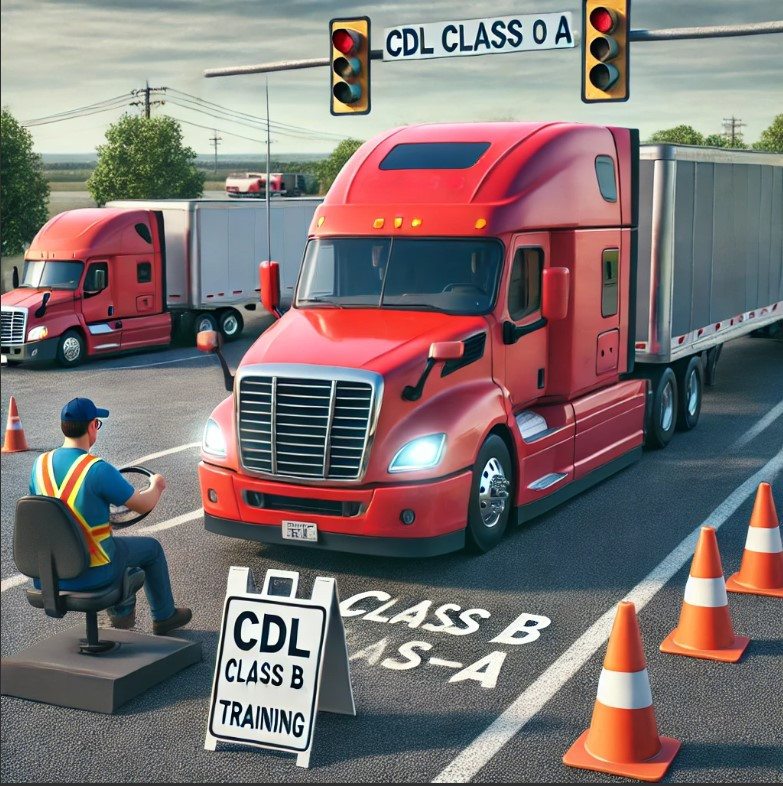Upgrading from a CDL Class B to a Class A license opens the door to greater career opportunities, higher pay, and the ability to operate larger commercial vehicles, including tractor-trailers and semi-trucks. Whether you’re an experienced bus driver, delivery truck operator, or someone looking to expand your skills, making the transition requires proper training, dedication, and hands-on experience.
At Get Drivers Ed, we provide comprehensive CDL training that equips you with the knowledge and skills necessary to make the jump from Class B to Class A CDL successfully. This guide will walk you through what to expect in the training process, key skills you’ll need to master, and proven strategies for success.
Understanding CDL Class B to A Training
If you already hold a CDL Class B, you’ve likely driven medium-sized commercial vehicles like buses, dump trucks, or straight trucks. However, upgrading to a Class A CDL allows you to operate larger, more complex vehicles, including tractor-trailers and combination vehicles.
1. Why Upgrade from Class B to Class A?
There are several compelling reasons why Class B drivers choose to upgrade to a Class A CDL:
Expanded Job Opportunities: Many trucking companies require a Class A license to drive interstate or long-haul routes.
Higher Earning Potential: Class A CDL drivers typically earn more than Class B drivers due to the complexity of the job.
More Driving Options: You can legally drive both Class A and Class B vehicles, increasing your versatility in the industry.
Better Job Security: Trucking is an in-demand profession, and Class A CDL holders often have more stable employment opportunities.
At Get Drivers Ed, we help drivers take the next step in their careers by providing FMCSA-compliant training that covers everything from vehicle control to safe driving practices.
What to Expect in CDL Class B to A Training
CDL training is divided into two key components: classroom instruction and behind-the-wheel training. Each plays a vital role in ensuring you are well-prepared to pass your CDL skills test and succeed in your new role.
2. Classroom Instruction: The Foundation of CDL Knowledge
Before hitting the road, you’ll need to complete the theory portion of CDL training. This section focuses on the rules, regulations, and best practices needed to operate a Class A vehicle safely.
Key topics covered in classroom training include:
Combination Vehicle Operation: Understanding how to drive semi-trucks and other Class A vehicles.
Air Brake Systems: Learning the differences between air brakes in Class A vs. Class B vehicles.
Coupling & Uncoupling Trailers: Mastering the correct procedures for connecting and disconnecting a trailer safely.
Federal & State Regulations: Staying compliant with FMCSA and DOT laws for commercial drivers.
Defensive Driving Techniques: Avoiding hazards and reacting safely in high-risk situations.
3. Behind-the-Wheel Training: Mastering Vehicle Control
Once you've completed the classroom portion, you’ll move on to behind-the-wheel (BTW) training, where you’ll gain hands-on experience driving a Class A vehicle.
Essential skills covered in behind-the-wheel training include:
Shifting & Transmission Control: Learning to operate manual and automatic transmissions in larger commercial vehicles.
Turning & Maneuvering: Understanding how to navigate tight turns, intersections, and wide lanes.
Backing & Parking: Mastering straight-line backing, offset backing, and alley dock parking.
Handling Cargo & Weight Distribution: Ensuring your truck is loaded properly for stability and safety.
Highway & City Driving: Practicing lane changes, merging, and adapting to different traffic conditions.
At Get Drivers Ed, we emphasize real-world driving scenarios to prepare you for the unique challenges of operating Class A vehicles.
How to Succeed in CDL Class B to A Training
Transitioning from a Class B to a Class A CDL requires more than just technical skills—it requires discipline, practice, and the right mindset. Here are some key strategies to help you succeed:
4. Tips for Passing Your CDL Class A Skills Test
Study the CDL Manual: Every state provides a CDL handbook that outlines all the essential information for passing the written exam.
Practice Pre-Trip Inspections: One of the most challenging parts of the CDL test is the pre-trip inspection—make sure you know how to inspect your vehicle properly.
Get Comfortable with Backing Maneuvers: Many CDL applicants struggle with backing up a semi-truck, so practicing different parking maneuvers is crucial for passing the test.
Stay Calm During Road Tests: Nerves can get the best of you during the on-road portion of the CDL exam. Stay calm, follow all safety rules, and demonstrate confidence behind the wheel.
Take Advantage of Professional Training: Enrolling in a structured CDL training program, like the one offered at Get Drivers Ed, gives you the best chance of success.
Conclusion: Take the Next Step with Get Drivers Ed
Upgrading from a Class B to a Class A CDL is a smart career move that unlocks better job opportunities, higher pay, and increased job security. However, making the transition requires proper training, hands-on experience, and dedication.
At Get Drivers Ed, we offer comprehensive CDL Class B to A training that prepares you for every aspect of the CDL exam and real-world trucking. Our FMCSA-approved program ensures that you gain the skills and confidence needed to excel as a Class A commercial driver.
Are you ready to take the next step in your driving career? Enroll in our CDL Class B to A training today at Get Drivers Ed and start your journey toward success!


